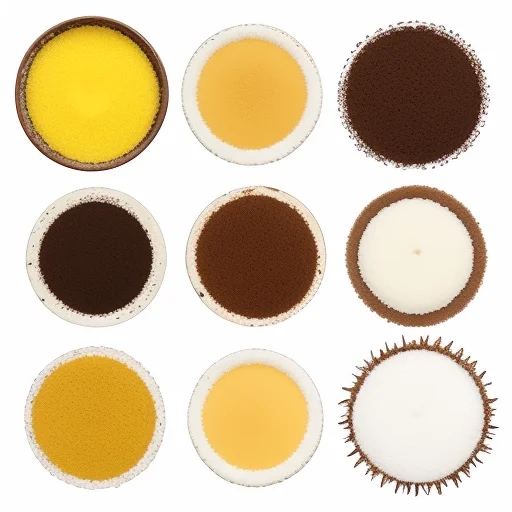As an Amazon Associate I earn from qualifying purchases.
Kitchen utensils are essential for preparing delicious meals, but over time these tools can accumulate unsightly rust spots that damage their appearance and performance. While you may be tempted to throw out heavily rusted pans, knives, and more, these quality cookware items don’t have to be discarded. How to remove rust from kitchen utensils ? a big confusion right but with a few DIY rust removal methods using common household ingredients, you can restore your kitchen gear to its former gleaming glory.
Causes of Bothersome Rust on Kitchen Utensils
Before learning how to remove stubborn rust, it’s helpful to understand what causes it in the first place. Rust forms when iron atoms in steel or iron utensils are exposed to oxygen and moisture. Frequent use of knives, pans, and other cooking implements introduces them to water and air during washing. Improper drying and inadequate storage accelerates rust formation. The constant abrasion from sponges and scouring pads also wears down protective coatings that keep metal surfaces rust-free.
Why It’s Important to Remove Rust Buildup
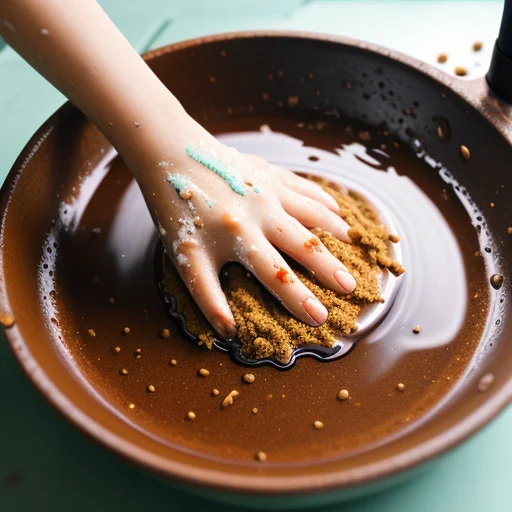
While rust may seem like just an aesthetic nuisance, there are good reasons to promptly clean it off your utensils:
- Restores appearance: Rust is an eyesore that detracts from the sleek look of high-quality pots, pans, blades, and more. Removing it makes kitchen tools shine like new again.
- Improves performance: As rust accumulates, it can interfere with the functionality of utensils, making knife blades duller and pan surfaces less slick. De-rusting restores effectiveness.
- Health considerations: Rust harbors bacteria that can contaminate food and beverages. Getting rid of rust helps kitchenware become more sanitary.
- Saves money: Allowing rust to progress may ruin cookware, necessitating costly replacements. Removing it promptly extends useful life.
- Increases value: For vintage or collectible items, restoration preserves or boosts resale value.
How To Remove Rust From Kitchen Utensils Effective Methods
Fortunately, the kitchen already contains common ingredients that can dissolve rust without damaging utensils. Here are some of the most effective DIY solutions:
Distilled White Vinegar for Knives and Blades
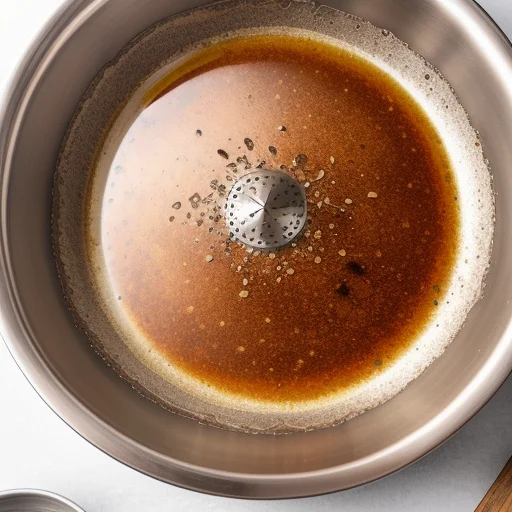
The acetic acid in vinegar dissolves rust while minimizing damage to metal. Follow these steps:
Supplies Needed:
- White distilled vinegar
- Bowl or shallow container
- Clean cloth or sponge
- Old toothbrush (optional)
Directions:
- Fill the container with undiluted white vinegar, enough to fully submerge the knife blade, scissors or other tool.
- Soak the utensil for 1-2 hours. For thick rust buildup, allow to soak overnight.
- Remove and scrub remaining rust away with a clean cloth, sponge or old toothbrush. Avoid abrasive scouring pads.
- For stubborn spots, apply more vinegar directly and let sit before scrubbing again.
- Rinse thoroughly with clean water and dry the utensil completely before use.
The vinegar technique also works well for other small metal kitchen tools like graters, skewers, whisks, and more. Make sure to rinse and dry thoroughly.
Baking Soda Paste for Pans and Bakeware
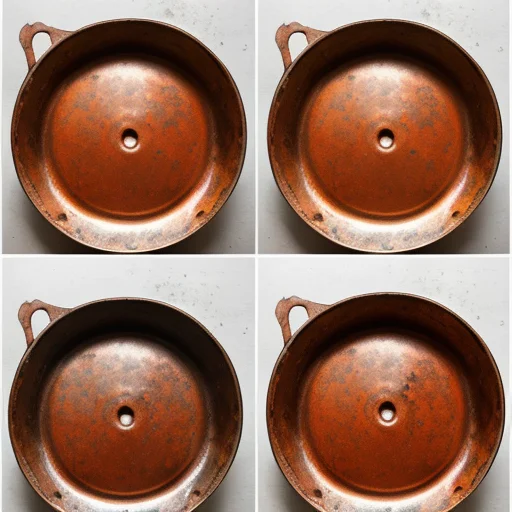
Baking soda’s gritty texture combined with its rust-fighting alkalinity make it ideal for cleaning pans with baked-on oxidation.
Supplies Needed:
- Baking soda
- Water
- Large plastic tub or basin
- Non-abrasive sponge or scrub brush
- Gloves and eye protection (optional)
Steps:
- In a small bowl, mix baking soda with just enough water to form a thick paste.
- Apply the paste liberally over rusted areas of the pan, covering completely.
- For large pans, place in a plastic tub or basin filled with the paste to submerge.
- Allow paste to sit for 1-3 hours. For severe rust, let sit overnight.
- Gently scrub rust spots with sponge/brush until they lift away. Repeat if needed.
- Rinse very thoroughly with clean water and dry the pan completely.
For old enamel pots and pans, test paste on a small area first to ensure it won’t damage the finish. Avoid using baking soda paste on aluminum to prevent darkening.
Raw Potato for Cast Iron Skillets
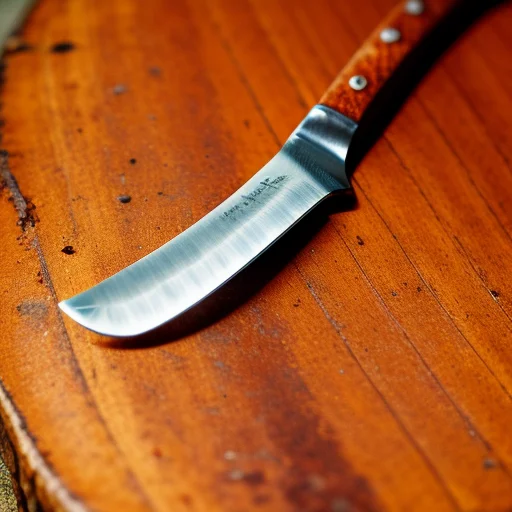
The oxalic acid in raw potatoes can dissolve rust without harming seasoned cast iron.
You’ll Need:
- 1-2 large raw potatoes
- Kosher salt or baking soda
- Clean cloth, paper towels, or sponge
Instructions:
- Scrub potato(es) under water to remove dirt but do not peel.
- Cut potato in half. Dip one half in salt or baking soda – the abrasive particles will aid scrubbing.
- Vigorously rub the salted/soda-coated potato all over rusted areas to lift rust. Re-apply more salt/baking soda as needed.
- Use the cut side of the potato to scrub indented cooking surfaces. Switch to the cloth, towel or sponge for hard-to-reach spots.
- Wipe away loosened rust. Repeat process if some rust remains.
- Re-season the skillet before use according to manufacturer’s directions.
The potato technique can also be used for other cast iron cookware like dutch ovens, griddles, grill pans and more. It’s a very effective rust remover for this material.
Lemon Juice or Vinegar Soak for Stainless Steel
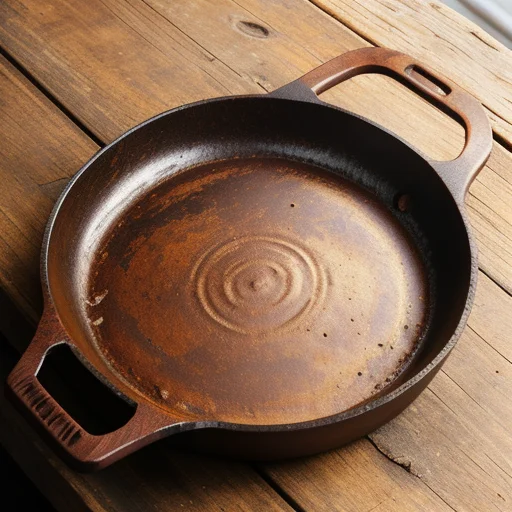
For stainless steel items like pots, utensils, or sink surfaces, try a lemon juice or vinegar soak.
You’ll Need:
- Fresh lemon juice or white vinegar
- Water
- Large plastic tub, basin, or sink
Steps:
- Fill container with enough water to fully submerge items.
- Add approximately 1 cup lemon juice OR 1/2 cup vinegar per gallon of water.
- Place rusted stainless steel items in soak solution. Smaller utensils can be grouped in a mesh bag for easy removal.
- Soak for 2-6 hours, checking periodically. More severe rust will require longer soaking.
- Remove and rinse items thoroughly. Use a soft cloth or sponge to wipe away any remaining rust.
- Dry well with a dish towel. Avoid air drying, as moisture could re-oxidize surfaces.
The citric and acetic acids tackle rust but are gentle enough for stainless steel. Avoid soaking more than 12 hours.
Molasses Soak for Iron and Cast Iron
Molasses contains acids that breakdown rust without damaging iron or cast iron surfaces.
Supplies Needed:
- Molasses
- Water
- Large plastic tub, basin, or bucket
Instructions:
- Create molasses soak solution – 1 part molasses to 4 parts hot water. Mix until dissolved.
- Place heavily rusted iron or cast iron item in tub and pour in molasses solution until fully submerged.
- Allow to soak overnight – at least 12 hours. Time depends on rust severity.
- Remove and scrub item with steel wool or scrub brush to remove any remaining rust residue.
- Rinse very thoroughly – molasses can leave sticky residue if not washed off entirely.
- Dry completely and season/polish item as desired before using.
The molasses technique works well for grates, antique iron pieces, waffle makers, griddles and more. Not ideal for fine cutting edges that could be dulled.
Tips for Restoring and Caring for De-Rusted Kitchenware
Once you’ve removed stubborn rust spots, take these extra steps to revitalize your cookware and help prevent future oxidation:
- Re-season cast iron with a thin coconut oil coating baked at high heat to restore nonstick properties. Avoid vegetable, olive and other oils that can turn rancid.
- Sharpen any blades, scissors, or graters to improve cutting ability. Use a sharpening stone, steel, or take them to a professional sharpening service.
- Smooth surfaces with super fine 000 steel wool to remove residue. Avoid regular steel wool grades that could further scratch cookware.
- Apply food-grade mineral oil to maintain wooden handles and boards. Choose mineral oil marketed as a butcher block conditioner or cutting board oil.
- Always hand wash and thoroughly dry utensils instead of tossing in the dishwasher. Let air dry completely before stowing cookware.
- Store cookware in a cool, dry place to inhibit moisture exposure. Avoid hanging utensils above the stove where steam can accelerate rusting.
- Use a dehumidifier in humid environments to keep ambient moisture levels reduced.
- Apply a protective wax coating like Renaissance Wax to maintain antique, collectible, or rarely-used items between uses.
- Don’t let food residue sit. Rinse or wipe away food left on utensils promptly to avoid damage from acids etching metal.
Hopefully You found your answer how to remove rust from kitchen utensils. With a bit of elbow grease and pantry staples like vinegar, baking soda, and molasses, you can give your tired kitchen tools a new lease on life. You can also follow these DIY methods to erase unsightly rust spots and restore the sleek look of your quality cookware. Then be diligent about drying, storage and maintenance to prevent recurring rust problems. Need help organizing all your shiny utensils? Check out how to organize kitchen utensils without drawers for great space-saving ideas.
As an Amazon Associate I earn from qualifying purchases.

